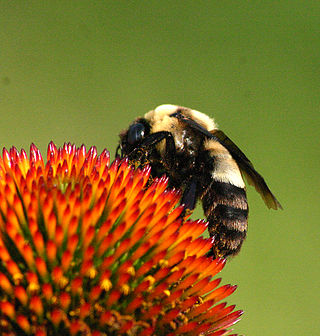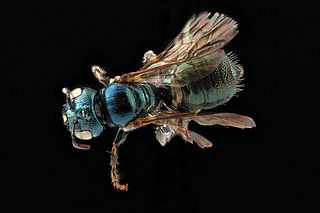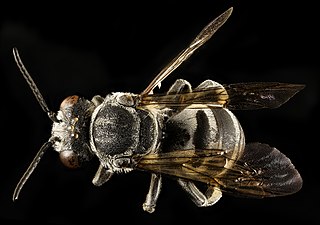
A bumblebee is any of over 250 species in the genus Bombus, part of Apidae, one of the bee families. This genus is the only extant group in the tribe Bombini, though a few extinct related genera are known from fossils. They are found primarily in higher altitudes or latitudes in the Northern Hemisphere, although they are also found in South America, where a few lowland tropical species have been identified. European bumblebees have also been introduced to New Zealand and Tasmania. Female bumblebees can sting repeatedly, but generally ignore humans and other animals.

Bombus fraternus is an endangered species of bumblebee known commonly as the Southern Plains bumblebee. It is native to the United States east of the Rocky Mountains. It is most often encountered in the southern Great Plains and along the Gulf Coastal Plain. This species has been found as far north as New Jersey and North Dakota, and as far south as Florida along the Gulf Coastal Plain into the state of Chihuahua in Mexico. This species was uncommon historically, but having faced declines in population; its estimated abundance is less than 15% of historical numbers.

Parasitellus is a genus of mites in the family Parasitidae which are obligatory parasites of bumblebees. These mites can be found clinging to the carapace, sometimes in large numbers. Mites in this genus hibernate in the deutonymphal stage. In the tritonymph stage they can actively transfer from bumblebee to bumblebee from flowers, where they can survive up to 24 hours. After they arrive in a bumblebee nest, they will moult into adults. Whilst it is not known what factors trigger the mite to molt, in laboratory conditions P. fucorum were found to moult after eating fresh pollen, although overall moulting success was low. They are kleptoparasitic or neutral to beneficial, depending on life stage; females and deutonymphs feed on provisioned pollen, while other stages are predators of small arthropods.
Nomada verecunda is a species in the family Apidae, in the order Hymenoptera . Nomada verecunda is found in North America.
Centris cockerelli is a species in the family Apidae, in the order Hymenoptera . The distribution range of Centris cockerelli includes Central America and North America.

Hoplitis anthocopoides is a species in the family Megachilidae, in the order Hymenoptera . The distribution range of Hoplitis anthocopoides includes Africa, Europe, Northern Asia, and North America.
Osmia glauca is a species in the genus Osmia, in the family Megachilidae . It is found in North America.
Triepeolus grandis is a species of cuckoo bees in the family Apidae. It is found in the United States and Mexico.

Triepeolus is a genus of cuckoo bees in the family Apidae. There are at least 140 described species in Triepeolus. The majority of species whose life history is known are kleptoparasitic in the nests of bees in the tribe Eucerini, especially the genera Melissodes and Svastra.

Ceratina strenua, the nimble ceratina, is a species of small carpenter bee in the family Apidae. It is found in North America.
Triepeolus rufithorax is a species of cuckoo bee in the family Apidae. It is found in North America.
Anthophora fedorica is a species of anthophorine bee in the family Apidae. It is found in North America.
Habropoda pallida, known generally as the pallid habropoda or white-faced bee, is a species of anthophorine bee in the family Apidae. It is found in Central America and North America. Females build nests and are particularly likely to provision the young with pollen from Larrea tridentata plants.

Dufourea is a genus of sweat bees in the family Halictidae. There are at least 160 described species in Dufourea.

Stelis is a genus of kleptoparasitic cuckoo bees in the family Megachilidae. There are at least 100 described species in Stelis.

Triepeolus donatus is a species of cuckoo bee in the family Apidae. It is found in North America.
Perdita rivalis is a species of mining bee in the family Andrenidae. It is found in North America.

Bombus sonorus, commonly known as the Sonoran bumble bee, is a species of bumble bee in the family Apidae. It is found in Central America and western and southwestern North America. Considered uncommon, it is sometimes categorized as a subspecies of Bombus pensylvanicus.

Bombus californicus, the California bumble bee, is a species of bumble bee in the family Apidae. Bombus californicus is in the subgenus Thoracobombus. It is found in Central America and the western half of North America. Bombus californicus is classified as Vulnerable by the IUCN.












